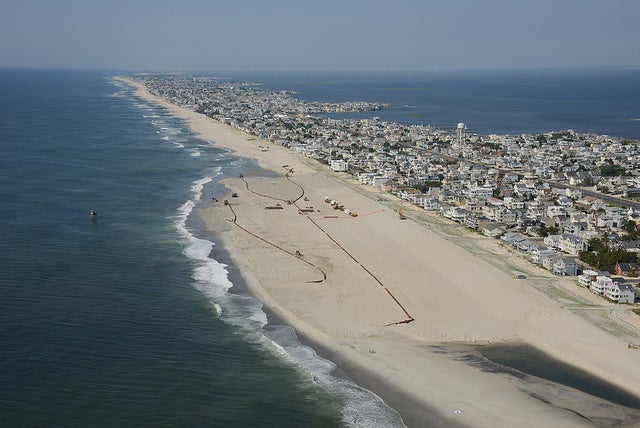Long Beach Island beachfill project moved up to April

The U.S. Army Corps of Engineers Philadelphia District pumps sand onto Brant Beach, NJ in June 2013. The work is part of an effort to restore the Coastal Storm Risk Management project from damages associated with Hurricane Sandy. (Image: U.S. Army Corps of Engineers)
A $128 million beach replenishment project in Long Beach Island will begin in April and last approximately one year, officials announced.
Originally slated to begin in mid-August, dredging equipment became available earlier than expected, allowing crews to start the first phase of beachfill around April 15, according to a U.S. Army Corps of Engineers release.
The project is an effort to reduce erosion and property damage associated with coastal storms.
A joint effort of the Army Corps and the New Jersey Department of Environmental Protection, crews will begin within Long Beach Township and proceed towards Holgate at the southern end of the island.
The project is slated to end by April 12, 2016.
“There are currently options on the contract for additional work that could add additional time to the contract completion date if awarded. Further, weather and or mechanical delays may cause a change in the construction schedule and completion date,” the release said.
Crews generally close 1,000-foot sections of the beach as work progresses at approximately 100 feet per day.
Dubbed the Long Beach Island Coastal Storm Damage Reduction project, the restoration and repair work will complete the initial construction of the dune and berm system on Long Beach Island that began in 2006.
The project is 100 percent funded through the Army Corps’ Flood Control and Coastal Emergencies program.
The Jersey Shore chapter of the Surfrider Foundation has been regularly critical of the ongoing beach replenishment along the entire New Jersey coastline, saying it creates more hazardous swimming conditions, generates poor quality sand, and negatively impacts wildlife.
WHYY is your source for fact-based, in-depth journalism and information. As a nonprofit organization, we rely on financial support from readers like you. Please give today.

